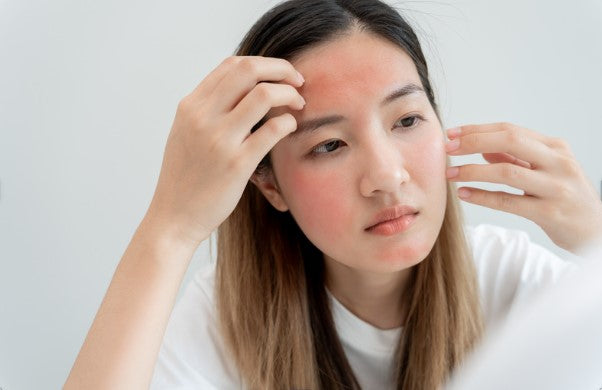
What is a sun rash?
Sun rash is a skin reaction that is caused by exposure to sunlight. It may cause irritation but usually does not lead to any serious complications. Sun rash usually resolves after a few days.
Quick links:
Let’s learn about the different types, symptoms, treatments, and preventions so you can stay educated and sun-safe.
What are the different types of sun rash?
According to the American Osteopathic College of Dermatology, a sun rash is the most common type of skin disease that occurs due to exposure to sunlight. There are three main types of sun rash:
- Polymorphous light eruption
- Photoallergic reaction
- Phototoxic reaction
Polymorphous light eruption
Polymorphous light eruption (PMLE) is the most common form of sun-induced skin reaction and is considered an immunologically mediated photosensitivity dermatosis. It typically occurs in spring or early summer when the skin is suddenly exposed to sunlight after a period of minimal sun exposure.
The exact cause of PMLE is unknown, but it is believed to be a delayed hypersensitivity reaction to an endogenous antigen in the skin that becomes altered upon exposure to ultraviolet (UV) light.
Genetics may play a role, as there is often a family history of the condition. PMLE is more prevalent in women and individuals with lighter skin, although it can affect anyone.
Photoallergic reaction
Photoallergic reactions occur when a substance on the skin reacts with sunlight, leading to an allergic response. This can happen with certain chemicals found in sunscreens, fragrances, cosmetics, or topical medications. When these substances are exposed to ultraviolet lights, they undergo a chemical change that triggers an immune reaction, resulting in a rash.
Unlike phototoxic reactions, photoallergic reactions involve the immune system and can spread to areas of the skin that were not exposed to sunlight.
Phototoxic reaction
Phototoxic reactions are more common than photoallergic reactions, and occur when a chemical substance on the skin becomes activated by sunlight, causing damage to the skin cells directly. This can lead to an exaggerated sunburn-like reaction, including redness, pain, and blistering.
Common culprits include certain medications (e.g., tetracyclines, sulfonamides), plants (e.g., limes, celery), and chemicals in sunscreens or cosmetics.
Unlike photoallergic reactions, phototoxic reactions do not involve the immune system and typically occur only in sun-exposed areas.
What causes a sun rash?
Doctors have yet to work out the exact cause of sun rash. Here are some factors that may lead to sun rash:
- UV radiation. UV radiation from the sun or artificial sources like tanning beds may cause skin reactions in people with a sensitivity to this type of light. The body's immune response to UV exposure triggers the development of the rash.
- Heat. High temperatures can cause the skin to become irritated and more sensitive to UV radiation, increasing the risk of sun rash.
- Sweat. Excessive sweating can clog pores and lead to skin irritation, making sun-exposed skin more susceptible to sun rash.
- Certain medications. Some medications, such as antibiotics, diuretics, and nonsteroidal anti-inflammatory drugs (NSAIDs), can increase skin sensitivity to sunlight and raise the risk of sun rash.
- Underlying skin conditions. People with pre-existing skin conditions like eczema or dermatitis may be more prone to developing sun rash when their skin is exposed to UV radiation.
Symptoms of sun rash
Sun rash symptoms can vary between individuals but typically appear within hours after sun exposure. The rash can develop on any part of the body exposed to sunlight, including areas that are usually covered during colder months, such as the chest or arms.
Common symptoms of sun rash include:
- Clusters of small, itchy bumps or blisters
- Red, irritated patches of skin
- Skin that feels hot or burning to the touch
- Rough or raised areas on the skin's surface
In some cases, individuals who experience severe sunburn alongside sun rash may also develop additional symptoms like fever or headache.
A rare type of sun rash called solar urticaria, or sun allergy hives, can cause more severe symptoms in addition to the typical rash. People with solar urticaria may experience:
- Dizziness or faintness
- Difficulty breathing
- Headaches
- Other allergy-related symptoms
How to prevent sun rash
These are precautions you can take to minimize your risk of sun rash:
- Sun protection
- Sunscreen
- Avoid peak sun hours
- Stay in the shade
- Increasing sun exposure
Sun protection
The best sun protection is a combination of sunscreen and sun-protective clothing. SwimZip offers high-quality sun-protective clothing that will keep you sun-safe.
From rash guards, swim dresses, and surf suits, to sun hats, sunglasses, and other accessories–we've got it all.
Sunscreen
Apply a broad-spectrum sunscreen with a sun protection factor (SPF) of at least 30 to all exposed skin, including your face, neck, ears, and hands.
Reapply sunscreen every 2 hours, or more frequently if you're swimming or sweating excessively. Choose a water-resistant sunscreen if you'll be engaging in water activities or sports.
Avoid peak sun hours
Stay indoors or in the shade during the sun's peak hours, typically between 10 am and 4 pm, when UV radiation is strongest.
Use our handy UV index tracker tool to stay informed and plan outdoor activities accordingly.
Stay in the shade
Seek shade under trees, umbrellas, or covered areas when outdoors during daylight hours.
Remember that while shade offers some protection, UV rays can still reflect off surfaces like sand, water, and concrete.
Increasing sun exposure
If you're prone to sun rash, gradually increase your sun exposure over time to allow your skin to adapt.
Start with short periods (e.g., 10-15 minutes of sun exposure) and gradually increase the duration over several weeks. This gradual exposure can help build your skin's tolerance to UV radiation and reduce the risk of sun rash.
If you’re going to tan, don’t do so during a high UV index. Read our guide on the best UV index for tanning to understand the dangers and how to tan more safely.
How to treat sun rash
If you develop sun rash, there are several treatment options available to help alleviate symptoms and promote healing. The following methods can be used to manage sun rash:
- Cool compresses. Apply cool, damp cloths or compresses to the affected areas to soothe the skin and reduce inflammation. Avoid using ice directly on the skin, as this can cause further irritation.
- Moisturizers. Use gentle, fragrance-free moisturizers to keep the skin hydrated and prevent dryness or flaking. Look for skin care products containing ingredients like aloe vera or calamine, which can help calm irritated skin.
- Oatmeal baths. Add colloidal oatmeal to lukewarm bath water and soak for 15-20 minutes to help relieve itching and inflammation. Colloidal oatmeal can be found in most pharmacies or made at home by grinding plain oats into a fine powder.
- Over-the-counter anti-itch creams. Apply over-the-counter hydrocortisone cream (0.5% or 1%) to the affected areas to reduce itching and inflammation.
- Oral antihistamines. Take over-the-counter oral antihistamines, such as diphenhydramine or loratadine, to relieve itching and reduce allergic responses. Be aware that antihistamines may cause drowsiness, so use caution when driving or operating machinery.
When should you contact a doctor?
If your sun rash symptoms persist or worsen despite home treatments, consult a medical professional for further evaluation and guidance. They can help determine the most effective treatment based on your individual needs and the severity of your condition.
You should also seek medical attention if you experience any of the following:
- Severe or widespread rash: if your sun rash covers a large portion of your body or is extremely painful, it's important to have it evaluated by a doctor.
- Blisters or open sores: if your sun rash is accompanied by blisters or open sores, there is a risk of infection. A healthcare provider can help manage these symptoms and prevent complications.
- Signs of infection: if you notice any signs of infection, such as increasing pain, redness, swelling, warmth, or discharge from the affected area, seek medical attention promptly.
- Persistent or worsening symptoms: if your sun rash does not improve within a few days or continues to worsen despite self-care measures, consult a doctor to rule out other potential causes and receive appropriate treatment.
- Recurrent sun rash: if you experience sun rash frequently or have a medical history of severe reactions to sun exposure, it's important to work with a dermatologist to develop a long-term management plan and discuss potential underlying conditions.
How long does sun rash last?
The duration of sun rash can vary depending on the severity of the reaction and the individual's skin type. In most cases, sun rash symptoms typically last for 5-7 days, but they can persist for up to 2-3 weeks for some individuals.
Factors that influence sun rash duration include:
- Severity of the allergic reaction. More severe reactions may take longer to resolve than milder ones. If the sun rash is accompanied by intense itching, blistering, or other signs of a strong allergic reaction, it may require more time to heal.
- Skin type. People with fair or sensitive skin (Fitzpatrick skin types I and II) may experience longer-lasting sun rash symptoms than those with darker skin types. This is because fair skin has less natural protection against UV radiation, making it more susceptible to damage and allergic reactions.
- Continued sun exposure. If the affected skin continues to be exposed to sunlight or UV radiation, the rash may persist or worsen.
- Underlying skin conditions. If an individual has pre-existing skin conditions like eczema or psoriasis, the sun rash may be more severe and take longer to resolve.
In some cases, a skin biopsy may be necessary to rule out other conditions and confirm the diagnosis of sun rash. This is particularly true if the rash persists for several weeks or is unresponsive to treatment.
If the sun rash persists for more than 2-3 weeks or is accompanied by severe symptoms, consult a dermatologist for further evaluation and treatment. They may prescribe stronger topical or oral medications to manage the allergic reaction and promote healing.
Risk factors
Some risk factors for certain kinds of sun rash can include:
Fair skin
People with fair or light-colored skin are more susceptible to sun rash because they have less natural protection from UV radiation.
Fair-skinned individuals often have lower levels of melanin, the pigment that gives color to the skin and helps protect against sun damage.
Family history
Having a family history of sun rash or other sun-related skin conditions may increase your risk of developing sun rash.
Genetic factors can influence your skin's sensitivity to UV radiation and its ability to defend itself against sun damage.
Certain medications
Some medications can increase your skin's sensitivity to sunlight, making you more prone to sun rash. These include:
- Antibiotics (e.g., tetracyclines, fluoroquinolones)
- Nonsteroidal anti-inflammatory drugs (NSAIDs)
- Diuretics
- Chemotherapy drugs
Always consult your doctor or pharmacist about potential sun sensitivity when starting new medications.
Weakened immune system
People with weakened or compromised immune systems may be more susceptible to sun rash and other sun-related skin problems.
Conditions that can weaken the immune system include HIV/AIDS, autoimmune disorders, and certain medications that suppress immune function (e.g., corticosteroids, immunosuppressants).
Sun rash vs. sun allergy
Sun rash and sun allergy are terms often used interchangeably, but they refer to slightly different concepts within the spectrum of skin reactions to sunlight.
Sun allergy specifically refers to a group of conditions where the immune system reacts to sunlight exposure, leading to skin changes. These reactions are a subset of sun rashes and involve an immunological response to the effects of UV radiation on the skin.
Sun allergies are characterized by symptoms such as redness, itching, and blistering that occur after sun exposure.
The main differences between sun rash and sun allergy are:
- Cause. Sun rash can be caused by a direct reaction to sunlight or a reaction to a substance on the skin that becomes activated by sunlight. Sun allergy, however, specifically involves an immune system reaction to sunlight.
- Symptoms. While both conditions can cause similar symptoms, the onset and severity can vary. Solar urticaria, a type of sun allergy, is notable for the rapid appearance of hives.
- Treatment. Treatment for both conditions involves avoiding sun exposure, using sunscreen, and applying topical treatments to alleviate symptoms. But, sun allergies may also require antihistamines or corticosteroids to manage the immune response.
Sun rash vs. sunburn
Although sun rash and sunburn are both caused by exposure to UV radiation, they are distinct conditions with different symptoms and underlying causes.
- Cause. Sun rash can be an immune response to sunlight or a reaction to substances on the skin, whereas sunburn is directly caused by UV radiation damage to the skin.
- Symptoms. Sun rash can present a variety of symptoms, including bumps, blisters, and hives, while sunburn typically results in red, painful, and sometimes blistered skin.
- Treatment. Both conditions require avoiding further sun exposure, but sun rash may also respond to antihistamines and corticosteroids, while sunburn treatment focuses on soothing and hydrating the skin.
Stay safe with Swimzip’s protective gear
SwimZip's sun-protective beach gear, crafted with UPF 50+ fabric, blocks 98% of harmful UVA and UVB rays to offer a high level of defense against sun damage.
We offer functional and fashionable sun-safe clothing. Our collections are chalk full of different styles and sizes so you can get the perfect picks for every member of the family.
Whether you're planning a day at the beach or an outdoor adventure, SwimZip's gear protects you from damaging rays.
Check out some of our popular collections:
Sun rash FAQ
Can a vitamin D deficiency cause a rash?
A vitamin D deficiency can cause skin problems, including rashes. Vitamin D is an important part of skin health, which reduces inflammation, supports skin cell growth, and prevents or alleviates conditions like eczema and psoriasis that manifest as rashes.
What is the difference between sun rash and sun poisoning?
Sun rash refers to different skin reactions to sunlight, including allergic and non-allergic responses. Sun poisoning, a more severe form of sunburn, involves symptoms like nausea, fever, and dehydration, with skin redness and blistering.
Is sun rash serious?
In most cases, sun rash is not serious and will resolve on its own within a few days to weeks. But, if the rash is severe, covers a large area of the body, or is accompanied by other symptoms such as fever or difficulty breathing, it may indicate a more serious condition requiring medical attention.
How to treat itchy rashes from sun exposure?
To treat itchy rashes from sun exposure:
- Apply cool compresses
- Take cool baths
- Use moisturizers
- Take oatmeal baths
- Apply over-the-counter anti-itch creams like hydrocortisone
- Consider oral antihistamines for relief
Note: avoid further sun exposure to prevent the worsening of the rash.
What is the difference between heat rash and sun poisoning?
Heat rash, also known as prickly heat or miliaria, is caused by blocked sweat glands and often occurs in hot, humid weather. It appears as small, itchy, red bumps or blisters. Sun poisoning is a severe reaction to UV radiation, causing a painful, blistering rash and flu-like symptoms.
What foods cause sun sensitivity?
Foods that cause sun sensitivity, or photosensitivity, include citrus fruits, celery, parsley, fennel, and carrots, which contain compounds called psoralens that can make the skin more sensitive to UV light. Some medications, such as antibiotics and diuretics, can also increase sun sensitivity.
What vitamins help sun rash?
Vitamins that support skin health may help prevent or manage sun rash, they include:
- Vitamin C is an antioxidant that protects the skin from UV damage and aids in collagen production.
- Vitamin D, obtained through sun exposure or supplements, is important for maintaining healthy skin and immune function.
- Vitamin E is another antioxidant that helps protect the skin from sun damage.
Further reading
What are the different types of tankini tops?
Resources
Polymorphous Light Eruption. (n.d.). American Osteopathic College of Dermatology. https://www.aocd.org/page/PolymorphousLightE




Leave a comment
This site is protected by hCaptcha and the hCaptcha Privacy Policy and Terms of Service apply.